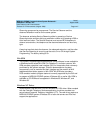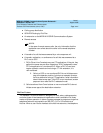
MERLIN LEGEND Communications System Release 6.1
Installation
555-661-140
Issue 1
August 1998
Prior Releases Features and Enhancements
Page xxxiii
Release 6.0 Enhancements (February, 1998)
time. In this case, time-based and number-of-calls based options take
precedence over overflow distribution based on the caller’s prompt.
When prompt-based overflow distribution is used, an extra TTR must be
provided for each delay announcement device assigned to the associated
calling group. The delay announcement informs the caller of the # key option to
exit the queue and leave rather than waiting for an agent. If no TTR is available
when a calling group call arrives, the call is not sent to a delay announcement
extension.
Centrex Transfer via Remote Call Forwarding
Centrex Transfer via Remote Call Forwarding can be used in all system modes
of operation to send outside calls to a remote telephone number or another
Centrex station. In this context, the term
outside
refers to calls that arrive on an
analog Centrex loop-start line at the MERLIN LEGEND Communications
System.
An outside call that uses this feature is defined as a call that arrives on an
analog Centrex loop-start line at the MERLIN LEGEND Communications
System. It may arrive directly or be transferred without consultation or without
transfer supervision (in the case of an automated attendant). The forwarding
call to the outside number is made on the same line/trunk on which the call
arrived, conserving system facilities.
Activating Centrex Transfer via Remote Call Forwarding is just like activating
regular Remote Call Forwarding and requires that Remote Call Forwarding be
enabled for the extension. However, the user dials
instead of a dial-out code,
and a Pause character may be required after the
. The Centrex service
provider determines whether the Pause is needed.
Pause cannot be originated from a single-line telephone or a remote access
user. A multiline telephone user in the local system must enter an authorization
code to activate the feature.
A remote access user may activate the feature without using an authorization
code. Barrier code requirements do apply, however.


















